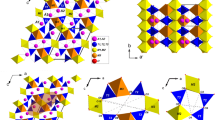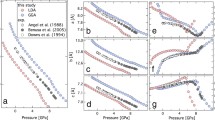Abstract
A dense polycrystalline aggregate of synthetic fayalite (Fe2SiO4) was deformed up to 8.5 GPa at room temperature in the D-DIA press installed at the European Synchrotron Radiation Facility beamline ID06. Five successive shortening–lengthening cycles were performed at different pressures and up to a final strain of approximately 25% at a typical strain rate of about 10−5 s−1. Lattice stresses were quantified from (hkl) reflections accessible with a 55-keV monochromatic beam. Combined stress and strain data show that during each cycle, fayalite deforms elastically before yielding at an axial strain close to 2%. This yielding occurs at a macroscopic stress (taken as the average of the estimated lattice stresses) of 1.5–2 GPa, irrespective of pressure. Very moderate stress hardening takes place beyond the yield point, and the average stress becomes almost constant after a strain of 5–6%, suggesting a low-temperature plastic regime. Lattice stresses estimated with (131), (130), and (022) reflections are always higher than stresses estimated with (111) and (112) by a factor of about 1.5. In addition, the (131) lattice stress becomes progressively lower than the (130) and (022) lattice stresses with increasing pressure, which suggests a possible change in dominant slip systems around 5–6 GPa. Combining our results with data from Chen et al. (Phys Earth Planet Inter 143–144:347–356, 2004), we determined a low-temperature plasticity flow law with an activation energy of 217 ± 25 kJ mol−1 and a Peierls stress at 0 GPa, σ p0 = 3.92 ± 0.02 GPa, that is consistent with dislocation motion being limited by discrete obstacles. The pressure dependence is almost entirely accounted for by the Peierls stress, with dσ p/dP = G′/G 0, where G′ is the derivative of G 0, the shear modulus. Our results suggest that fayalite has a smaller pressure dependence of low-temperature plasticity than (Mg0.9Fe0.1)2SiO4 and that the transition between low-temperature plasticity and high-temperature creep occurs at lower temperatures and lower stresses in fayalite than in Mg-rich olivines. An increase in iron content in olivine may therefore enhance ductility and lower the effect of pressure on creep, resulting in a viscosity contrast of up to 50 between fayalite and (Mg0.9Fe0.1)2SiO4 at pressures and temperatures of the lithospheric mantle.











Similar content being viewed by others
References
Béjina F, Bystricky M (2009) Use of the spark plasma sintering technique for the synthesis of dense mineral aggregates suitable for high-pressure experiments. High Press Res 29:630–634
Bollinger C, Raterron P, Castelanu O, Detrez F, Merkel S (2016) Textures in deforming forstérite aggregates up to 8 GPa and 1673 K. Phys Chem Miner 43:409–417
Burnley PC (2015) Elastic plastic self-consistent (EPSC) modelling of plastic deformation in fayalite olivine. Am Mineral 100:1424–1433
Byerlee JD (1968) Brittle-ductile transition in rocks. J Geophys Res 73:4741–4750
Byerlee JD (1978) Friction of rocks. Pure Appl Geophys 116:615–626
Chen J, Li L, Weidner D, Vaughan M (2004) Deformation experiments using synchrotron X-rays: in situ stress and strain measurements at high pressure and temperature. Phys Earth Planet Inter 143–144:347–356
Chen J, Li L, Yu T, Long H, Weidner D, Wang L, Vaughan M (2006) Do Reuss and Voigt bounds really bound in high pressure rheology experiments? J Phys Condens Matter 18:1049–1059
Demouchy S, Tommasi A, Boffa Ballaran T, Cordier P (2013) Low strength of Earth’s uppermost mantle inferred from tri-axial deformation experiments on dry olivine crystals. Phys Earth Planet Inter 220:37–49
Druiventak A, Trepmann CA, Renner J, Hanke K (2011) Low-temperature plasticity of olivine during high stress deformation of peridotite at lithospheric conditions—an experimental study. Earth Planet Sci Lett 311:199–211
Evans B, Goetze C (1979) The temperature variation of hardness of olivine and its implication for polycrystalline yield stress. J Geophys Res 84:5505–5524
Frost HJ, Ashby MF (1982) Deformation-mechanism maps. Elsevier, New York, pp 108–110
Graham EK, Schwab JA, Sopkin SM, Takei H (1988) The pressure and temperature dependence of the elastic properties of single-crystal fayalite Fe2SiO4. Phys Chem Miner 16:186–198
Guignard J, Crichton WA (2015) The large volume press (LVP) facility at ID06 beamline of the ESRF as a HPHT deformation apparatus. Rev Sci Instrum 86:085112-1–08511210
Guignard J, Bystricky M, Béjina F (2011) Dense fine-grained aggregates prepared by spark plasma sintering (SPS), an original technique in experimental petrology. Eur J Mineral 23:323–331
Hammersley AP (1997) FIT2D: an introduction and overview. ESRF internal rep. ESRF97HA02T. European Synchrotron Radiation Facility, Grenoble
Hazen RM (1977) Effects of temperature and pressure on the crystal structure of ferromagnesian olivine. Am Mineral 62:286–295
Hilairet N, Wang Y, Sanehira T, Merkel S, Mei S (2012) Deformation of olivine under mantle conditions: an in situ high-pressure, high temperature study using monochromatic synchrotron radiation. J Geophys Res 117(B01203):1–16
Hirth G, Kohlstedt D (2003) Rheology of the upper mantle and the mantle wedge: a view from the experimentalists. Geophys Monogr 138:83–105
Holland TJB, Redfern SAT (1997) Unit cell refinement from powder diffraction data: the use of regression diagnostics. Mineral Mag 61:65–77
Hunt SA, Dobson DP, Wood IG, Brodholt JP, Mecklenburgh J, Oliver EC (2009) Deformation of olivine at 5 GPa and 350–900 °C. Phys Earth Planet Inter 172:84–90
Karato S-I (2010) Rheology of the deep upper mantle and its implications for the preservation of the continental roots: a review. Tectonophysics 481:82–96
Kawazoe T, Karato S-I, Otsuka K, Jing Z, Mookherjee M (2009) Shear deformation of dry polycrystalline olivine under deep upper mantle conditions using a rotational Drickamer apparatus (RDA). Phys Earth Planet Inter 174:128–137
Kocks UF, Argon AS, Ashby MF (1975) Thermodynamics and kinetics of slip. Pergamon, Oxford
Kohlstedt DL, Evans B, Mackwell SJ (1995) Strength of lithosphere: constrained imposed by laboratory experiments. J Geophys Res 100:17587–17602
Kranjc K, Rouse Z, Flores KM, Skemer P (2016) Low-temperature plastic rheology of olivine determined by nanoindentation. Geophys Res Lett 43:176–184. doi:10.1002/2015GL065837
Le Godec Y, Martinez-Garcia D, Mezouar M, Syfosse G, Itie J-P, Besson JM (2000) Thermoelastic behaviour of hexagonal graphite-like boron nitride. High Press Res 17:35–46
Linckens J, Herwegh M, Müntener O, Mercolli I (2011) Evolution of a polymineralic mantle shear zone and the role of second phase in the localisation of deformation. J Geophys Res 116(B06210):1–21
Long H, Weidner DJ, Li L, Chen J, Wang L (2011) Deformation of olivine at subduction zone conditions determined from in situ measurements with synchrotron radiation. Phys Earth Planet Inter 186:23–35
Lutterotti L, Bortolotti M, Ischia G, Lonardelli I, Wenk H-R (2007) Rietveld texture analysis from diffraction images. Z Kristallogr Suppl 26:125–130
Meade C, Jeanloz R (1990) The strength of mantle silicate at high pressure and room temperature: implications for the viscosity of the mantle. Nature 348:533–535
Mei S, Suzuki AM, Kohlstedt DL, Dixon NA, Durham WB (2010) Experimental constraints on the strength of the lithospheric mantle. J Geophys Res 115:1–9
Nishihara Y, Funakoshi K-I, Higo Y, Tsujinom N, Kawazoe T, Kubo T, Shimojuku A, Terasaki H, Nishiyama N (2010) Stress relaxation experiments of olivine under conditions of subducted slab in Earth’s deep upper mantle. Phys Earth Planet Inter 183:164–174
Nishihara Y, Ohuchi T, Kawazoe T, Spengler D, Tasaka M, Kikegawa T, Suzuki A, Ohtani E (2014) Rheology of fine-grained forsterite aggregate at deep upper mantle conditions. JGR Solid Earth 119:253–273
Nishiyama N, Wang Y, Uchida T, Irifune T, Rivers ML, Sutton SR (2005) Pressure and strain dependence of the strength of sintered polycrystalline Mg2SiO4 ringwoodite. Geophys Res Lett 32:1–4
Orowan E (1940) Problems of plastic gliding. Proc Phys Soc 52:8–22
Poirier J-P (1985) Creep of crystals. Cambridge University Press, New York
Précigout J, Gueydan F (2009) Mantle weakening and strain localisation: implications for the long-term strength of the continental lithosphere. Geology 37:147–150
Proietti A, Bystricky M, Guignard J, Béjina F, Crichton WA (2016) Effect of pressure on the strength of olivine at room temperature. Phys Earth Planet Inter 259:34–44
Raterron P, Wu Y, Weidner DJ, Chen J (2004) Low-temperature olivine rheology at high pressure. Phys Earth Planet Inter 145:149–159
Shiraishi R, Ohtani E, Kubo T, Doi N, Suzuki A, Shimojuku A, Kato T, Kikegawa T (2011) Deformation in cubic anvil press and stress and strain measurements using monochromatic X-rays at high pressure and high temperature. High Press Res 31:399–406
Singh AK, Balasingh C, Mao H-K, Hemley RJ, Shu J (1998) Analysis of lattice strains measured under nonhydrostatic pressure. J Appl Phys 83:7567–7575
Smyth JR (1975) High temperature crystal chemistry of fayalite. Am Mineral 60:1092–1097
Speziale S, Duffy TS, Angel RJ (2004) Single-crystal elasticity of fayalite to 12 GPa. J Geophys Res 109(B12202):1–15
Sung C, Goetze C, Mao H (1977) Pressure distribution in the diamond anvil press and the shear strength of fayalite. Rev Sci Instrum 48:1386–1391
Takeda M, Onishi T, Nakakubo S, Fujimoto S (2009) Physical properties of iron-oxide scales on Si-containing steels at high temperature. Mater Trans 50:2242–2246
Uchida T, Funamori N, Yagi T (1996) Lattice strains in crystals under uniaxial stress field. J Appl Phys 80:739–746
Uchida T, Wang Y, Rivers ML, Sutton SR (2004) Yield strength and strain hardening of MgO up to 8 GPa measured in the deformation-DIA with monochromatic X-ray diffraction. Earth Planet Sci Lett 226:117–126
Warren JM, Hirth G (2006) Grain size sensitive deformation mechanisms in naturally deformed peridotites. Earth Planet Sci Lett 248:438–450
Weidner DJ, Chen J, Xu Y, Wu Y, Vaughan MT, Li L (2001) Subduction zone rheology. Phys Earth Planet Inter 127:67–81
Yagi T, Ida Y, Sato Y, Akimoto S-Y (1975) Effect of hydrostatic pressure on the lattice parameters of Fe2SiO4 olivine up to 70 kbar. Phys Earth Planet Inter 10:348–354
Yamamoto J, Ando J-I, Kagi H, Inoue T, Yamada A, Yamazaki D, Irifune T (2008) IN situ strength measurements on natural upper-mantle minerals. Phys Chem Miner 35:249–257
Zhao Y-H, Zimmerman ME, Kohlstedt DL (2009) Effect of iron content on the creep behaviour of olivine: 1. Anhydrous conditions. Earth Planet Sci Lett 287:229–240
Acknowledgements
Authors are very grateful for the help provided during SPS synthesis by G. Chevallier at PNF2, Toulouse. Authors acknowledge the European Synchrotron Radiation Facility (ESRF) for provision of synchrotron facilities and thank ESRF and ID06 beamline staff for the help provided during beamtime. MB, FB, and AP acknowledge the support of the French Agence Nationale de la Recherche (ANR) under grant ANR-JCJC-SIMI6-LS-100197-01-R-01 (RHUM project). Many thanks to A.Hammersley for his help in Fit2D development for the new detection setup.
Author information
Authors and Affiliations
Corresponding author
Electronic supplementary material
Below is the link to the electronic supplementary material.
Rights and permissions
About this article
Cite this article
Guignard, J., Bystricky, M., Béjina, F. et al. Strength of fayalite up to 8.5 GPa. Phys Chem Minerals 44, 403–417 (2017). https://doi.org/10.1007/s00269-016-0867-9
Received:
Accepted:
Published:
Issue Date:
DOI: https://doi.org/10.1007/s00269-016-0867-9




